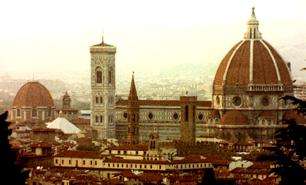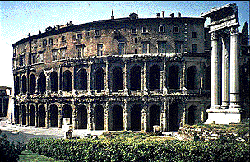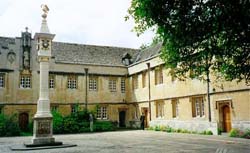
Famous view of Florence, Italy, arguably the most influential city of the Renaissance.
|
One of the cities that exemplified these new trends was Florence. The
leading citizens of Florence, the Medici family, made their wealth as
business people (in other words, instead of starting as nobility
they had middle class beginnings). All of these factors contributed to
Italy being the birth place of the Renaissance.
However this movement did not stay confined to Italy for long. This new
enthusiasm for learning spread north to Germany and extended as far as Scotland,
north of the Alps, and became known as Humanism.
The Renaissance and Humanism movements were about becoming intellectually
free from the Church. People had grown tired of the lives the Church thought
they should live. The Church had way more power then it does now, literally
controlling every aspect of life. The Church demanded that scholars, scientists
and artists use their work to exalt the heavens and severely punished anyone
who chose to do otherwise.
With more freedom from the Church, the Renaissance became a time for individual
expression, self-conciousness, and pursuit of knowledge. The Renaissance started
to define the world as you and I know it; the revival of literature and art,
the ability to express criticism without threat of punishment, the freedom of
intelligence from the control of the Church, the invention of the printing press,
the discoveries of navigation and the exploration of America and the East,
as well as the definition of the solar system.

The ancient Coliseum of Rome.
Chock-full of relics from ancient Roman times, Rome
was primed for the revival of the classics.
|
Like the Renaissance, the achievements of the Humanist movement were to recover
literary treasures and monuments of ancient Greece and Rome. Not since the
Greek and Roman times had people been allowed to explore their own philosophies
and write literature that was about mere worldly things.
To science, this meant a new way of experimenting based on observation and
a new way of interpreting
findings based on the world around us instead of worrying about whether
these discovers contradicted the Bible.
The "Scientific Principle", which you are familiar with, arose from this time:
you don't just accept whatever you're told, but you test the truth of it.
The Renaissance allowed people to start to develop a sense of morality
based on what society believed was right and wrong, and choose ways to enforce
this morality. Before the Renaissance, morals came from the Church's strict
interpretation of the Word of God and this was not always a fun view of
what life should include.
What was the difference between The Renaissance and Humanism?
The Renaissance was fed by individual creators and individual accomplishment.
In the new culture north of the Alps, the Humanist movement, the universities
and schools played a much more important part than in the south.
The representatives of the new scholarship were teachers.
Humanism gave birth to the idea of useful education for all people, and the idea
of a "well rounded" schooling in many different fields of learning.
In addition, the humanists, in general, were not as creative as the artists in Italy.
It was a general improvement of the masses, and not the outstanding contributions of
a few. That is not to say that there were no outstanding individuals in the
humanist movements.
Bonus: We'll give you 30 clams for distinguishing the famous Renaissance
people from the famous Humanists presented in this series. Additionally, we
will give you 100 clams if you can tell us one individual achievement for each
of those people.

University of Oxford in
Oxford, England, was an important hub for the Humanist movement.
|
The humanists drew the seperation between Church and state more clearly then
that of the Renissance. The humanist idea held that the Church should not
rule civic matters, but should guide only spiritual matters. Many states
began to separate themselves from the Church to improve their self-image
and this gave rise to a spirit of nationalism.
Spiritualism became popular, and the search for a direct experience of God
led people to belief things other than what the Church originally desired.
Increased study of the Bible led people to differing views of how the
Church should be. As a result, the Church became less powerful and the individual and
governement became more powerful.
That a Renaissance was needed is a startling fact in Western history.
The key to the start of the Renaissance was individuals rebelling
against authority. This is as true now as it was then. Great thinkers and
creators march to their own drummers, respecting, though not necessarily following
the beat of others.
Do you march to your own drummer?